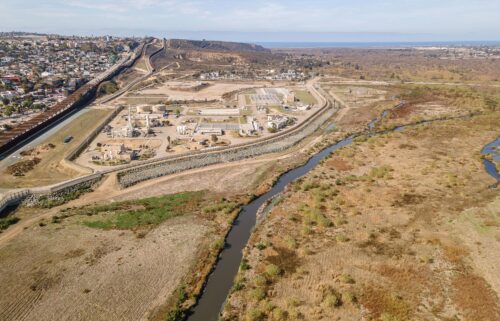Gray wolves should have over one-third of Western federal lands, experts say
By Megan Marples, CNN
Gray wolves may be getting a major habitat upgrade, if these experts have any say, that is.
A group of researchers from across the United States wrote a proposal that would include setting aside a significant amount of federal land as a sanctuary for gray wolves and other animals such as beavers, and it’s known as the Western Rewilding Network, according to a report published August 9 in the journal BioScience.
“Although gray wolves and beavers currently have low risk of extinction, we are very concerned that these keystone species have been lost from many ecosystems across the American West,” said report coauthor Christopher Wolf, a postdoctoral scholar in the College of Forestry at Oregon State University in Corvallis.
Keystone species are animals that an ecosystem heavily depends on for overall health.
If federal action creates protections that allow gray wolf populations to rebound, they could offer significant ecological benefits, including controlling the number of ungulates, which are hoofed animals like elk and deer.
Keeping these grazers in check in turn would aid in the regrowth of plants and trees like aspen that have been negatively affected by the drop in biodiversity, said report coauthor William Ripple, distinguished professor of ecology in the College of Forestry at Oregon State University.
The proposed area would total approximately 191,500 square miles (496,000 square kilometers) across 11 Western states, which is about 16% of the total land mass of those states, Wolf said.
Some of the proposed protected regions include Yellowstone National Park, the Northern and Southern Rockies, and the Mogollon Plateau, the report said.
The federal government owns about 47% of the Western region of the US, so the area would take up roughly 34% of federal land in the West, he said. Wolves require a vast amount of territory to live, so a large quantity of land is key to their survival, Wolf added.
The 11 states are Arizona, California, Oregon, New Mexico, Washington, Nevada, Idaho, Montana, Wyoming, Colorado and Utah.
Federal law has protected gray wolves on and off since the 1970s with the creation of the Endangered Species Act, which protects species that are at risk of extinction, Ripple said.
Wildlife conservationists have credited this act with saving species like the bald eagle from extinction, he added.
The government has received pushback from some people who want to prioritize predator management programs to reduce predation.
As of February 2022, gray wolves are generally protected in the continental US under the act, except for wolves in the Northern Rocky Mountains, Ripple said.
Gray wolves and beaver populations are currently stable, but are still much diminished from historic mass killings, Wolf said.
Why do gray wolves and beavers need to repopulate?
Most gray wolves disappeared in the early 1900s because ranchers moved into the wolves’ habitats with their livestock, said coauthor Robert Lee Beschta, professor emeritus in the department of forest ecosystems and society at Oregon State University.
The wolves posed a threat to ranch animals, so the predators were often killed, he said. Because gray wolves are federally protected, hunting them now is illegal, according to the US Fish & Wildlife Service. The ruling does not extend to gray wolves in the Northern Rocky Mountains that are able to be hunted in accordance with individual state laws, the organization said.
Trappers heavily hunted beavers for the fur trade in the 1800s, reducing the North American population by about 90% to 98%, but the species made a comeback in the early 1900s, Wolf said.
“Despite this recovery, beavers are still absent from many streams that they likely formerly inhabited,” he said.
Why is it important to revive wolf and beaver populations?
Gray wolves are apex predators, meaning they are at the top of their food chain, Ripple said.
When they are all but removed from the ecosystem, the populations of ungulates grow dramatically since wolves are not there to prey on them, he said.
This can lead to the ungulates overgrazing, which stops some plants and trees from growing and lowers the biodiversity, Beschta said.
Beavers play a crucial role in ecosystems and act as engineers building dams, which offers numerous benefits to the environment, the report said.
The structures created by beavers enrich the fish habitat, aid in water flowing during droughts, improve water quality, better the habitat of numerous plants and animals and more, according to the report.
“The ponds and wetlands constructed by beavers can serve as natural fire breaks in the case of wildfire,” Ripple said.
Reducing grazing permits
As part of the proposal, the researchers also recommended limiting grazing permits on that federal land in the West. The federal government gives grazing permits to ranchers to allow their herds to graze on certain public lands.
The livestock have been associated with the reduction of many native plant and animal species due to trampling or grazing, Wolf said.
The researchers suggested the federal government offer buyouts to ranchers to incentivize them to leave, the report said.
Ranchers could use the money however they want, like retiring or purchasing private land to continue with their livelihood, Beschta said.
CNN reached out to the US Bureau of Land Management, the agency in charge of federal lands and issuing grazing permits, and it has not yet commented on the record to CNN on the proposal.
Next steps for protection
The researchers have not yet discussed their proposal with the federal government, Ripple said.
It would also be a significant financial investment, Beschta said, but he hopes the government will be willing to accept their recommendations because of the vast ecological benefits.
There are also numerous agencies and groups of people who would need to coordinate the execution of the proposal, Wolf said.
“The decision to move forward with these recommendations ultimately depends on the wishes of the American people and various stakeholders, including local communities, livestock ranchers, hunters, and various other groups,” he said.
The-CNN-Wire
™ & © 2022 Cable News Network, Inc., a Warner Bros. Discovery Company. All rights reserved.



